Diseases Associated with the Breeding of Parrots
Common diseases of parrots are discussed elsewhere on this site (Common Diseases of Parrots, Psittacosis, As Sick as a Parrot), but this article deals with conditions affecting the breeding of parrots and rearing of chicks.
NEONATAL (PAEDIATRIC) DISEASES
Dead in Shell. Embryos dying during incubation are most commonly the result of problems with temperature and humidity. Therefore, careful monitoring of the incubator is paramount. Chilling of the egg will suspend the development of the embryo, and prolonged periods of cold will kill it. Excess heat will dehydrate it, as will insufficient humidity; while humidity that is too high will result in a water-logged egg and drowning of the embryo. Occasionally, infectious agents may get in to the egg, and sometimes there are genetic or toxic factors involved. The cause of early embryonic death may be investigated by an experienced veterinarian or laboratory, but the egg has to be fresh (within a few hours) since secondary bacterial contaminants will quickly grow in the egg and mask the true problem.
Death at Hatching is commonly the result of dehydration because humidity is not high enough during the hatching period. Shell membranes dry out and the shell becomes hard, while the chick gets stuck to its membranes and weakens. Humidity at this time needs to be around 70%, and drops of water may be applied to the chick’s beak tip as it works at the crack in the shell. Alternatively, there may be too much interference on the part of the bird-keeper, leading to haemorrhage in the egg or the introduction of infection. Mal-positioning results from dehydration or insufficient turning of the egg during incubation, so that again the chick will stick to shell membranes and be unable to manoeuvre.
Omphalitis, or yolk sac infection results from a delay of the sac to be absorbed; premature hatching; or too much handling of the chick.
Deformity or Stunting of chicks can result from incubation temperatures that are too high; poor nutrition of the parents; or genetic influences.
Healthy Chicks should be alert and beg in response to sound or movement. The skin should be smooth and pale pink. Babies that are dehydrated will appear grey and wrinkled, while those that have septicaemia will be dark red and wrinkled. Both will be sleepy and inactive.
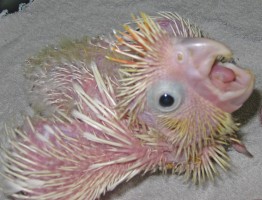
Healthy Citron-crested cockatoo chick, strong, begging for food, new feathers a light pink skin
Several viruses affect parrot chicks, and full details of these infections are given elsewhere. The most important are Polyomavirus and Psittacine Beak & Feather Disease (PBFD). The former will cause rapid death in young chicks, showing a very pale skin colour, with small spots of haemorrhage. PBFD generally affects slightly older chicks, as they start to grow feathers. The new feathers will be clubbed or constricted, and will fall out easily. Birds will die with acute organ failure or secondary infection as their immune systems are severely damaged. Proventricular Dilatation Disease (PDD) will affect weaning birds, resulting in death following a distended stomach, weight loss, vomiting, diarrhoea with undigested food particles, and nervous signs. Being infectious diseases, these conditions are most commonly a problem in large nurseries, especially where chicks are obtained from several sources. Thus, having a closed, limited population, or an ‘all-in, all-out’ policy, with good hygiene practice and fumigation of the premises between batches, will go a long way towards controlling such infections.
Red urine is seen particularly in juvenile African grey parrots, and occasionally Pionus and Amazons, and is not a cause for alarm. It appears to be a reaction between ingredients in the feeding formula with chemicals (possibly bleach) in paper towelling. A change of food or bedding and the colour will disappear!
Mouth and throat infections are common in baby parrots, and will follow poor feeding techniques, contaminated food, or physical damage from parent birds, siblings in the nest, or the hand-feeding utensils. The infectious agents may be either bacteria or yeasts, so swabs from the mouth should be cultured and examined to identify the agent. Bacteria will require antibiotic treatment; yeasts will need anti-fungal drugs such as nystatin.
Crop problems are common. They include puncture by the feeding tube, especially if not using one with a rounded tip, and in strong-pumping feeders like macaws. The hole would require surgical repair. Foreign bodies include portions (or even the whole length!) of rubber feeding tubes swallowed by the chick, but most frequently the problem would be wood shaving or chips used as a nesting material. Small pieces will be softened, partially digested, and will eventually pass through, but larger fragments will lodge in the crop or stomach and will prevent food going down. If quickly identified, fresh fragments may be massaged back up through the mouth. Otherwise, a very liquid diet, with some lubrication like liquid paraffin or corn oil will encourage passage of the material. Extreme cases may require surgical removal.
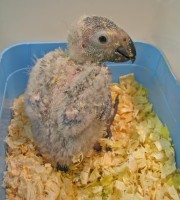
African grey chick bedded on wood shavings
Crop stasis is a frequent problem. Food material accumulates in this organ, and may rapidly ferment and develop secondary infections – ‘sour crop’. Reasons would include hypothermia, dehydration, foreign bodies, or infections. Large volumes of liquid content need to be massaged out, with the chick turned upside down so that it does not choke in the process. This should be followed by small, frequent, very liquid meals. It helps to slightly acidify the formula by adding a few drops of lemon juice or apple cider vinegar. Swabs from the crop content should be taken to check for bacteria or yeasts, and antibiotic or anti-fungal treatment given if required.
Occasionally, the crop may become seriously over-distended, so that it sags down over the chest and cannot empty because the contents are below the oesophageal exit. These may be treated with a ‘crop bra’ of soft tape wrapped around the lower neck and chest, to lift up the crop, at the same time feeding small, frequent meals.
Crop burns are a serious complication of feeding food that is too hot. This is easily done if formula is heated in a microwave oven and not thoroughly stirred. ‘Hot spots’ in the mix will scald the sensitive inner lining of the crop, leading to localised inflammation, ulceration, and secondary infection. The chick will be become dull and reluctant to feed, and after several days the ulceration may break through the crop wall and the overlying skin. Often the first sign noticed by the keeper is food dribbling out of a hole in the bird’s neck! This damage requires surgical repair, but the veterinarian will need to wait until the burned tissue has showed its full extent. Suturing the wound too early will result in breakdown as more flesh dies back and the stitches pull out. All dead tissue will need to be removed, and healthy crop wall sutured together, with the skin similarly repaired in a separate layer.
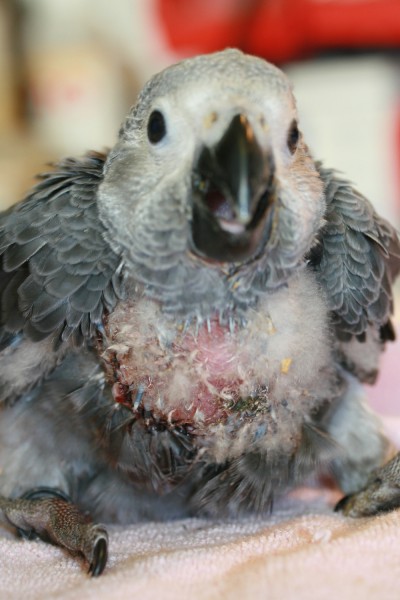
African grey parrot chick recovering from surgery to repair a perforating ulcer in the crop resulting from food fed too hot. A line of sutures may be seen along the lower left border of the pink skin over the full crop.
Injuries may be inflicted by parent birds due to inexperience, disturbance, or a desire to breed again. This may be as mild as a little feather plucking over the head and neck, but can include the removal of toes, wing tips, or even beaks.
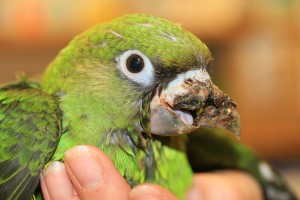
Young Jardine's parrot with its upper beak torn away by its parents
Skeletal problems are also common in parrot chicks. Most frequently encountered is Metabolic Bone Disease (MBD) – commonly known as ‘rickets’, and is the result of nutritional imbalance. Usually a lack of calcium and vitamin D, with too much phosphorus in the diet fed to the parent birds (Hypocalcaemia). African grey and Eclectus parrots seem particularly susceptible. Affected chicks will show splayed legs or folding fractures of the long bones of the legs and wings. If caught early enough, splayed legs may be hobbled together with soft tape. Fractures in soft, rapidly growing bones may be strapped and splinted, and will heal quickly if calcium supplements are added to the diet. The affected chicks will need support with crumpled paper in the nest container to keep the legs together. More advanced cases may need to have the deformed bone broken and re-set surgically when the bird is mature enough to withstand such an operation. Skeletal injuries of this type may be exacerbated by careless restraint of the chicks when hand-feeding, or by over-activity of the growing heavy chick on soft, weakened bones.
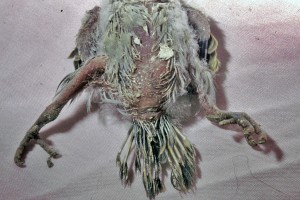
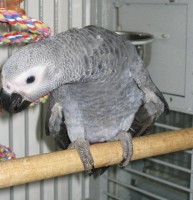
Left - splayed legs in a budgerigar chick; Right - young grey parrot with drooping wings resulting from bowing of the long bones caused by metabolic bone disease.
Constricted toes are found in African grey and Eclectus parrots as well as large macaws. The affected digit will appear swollen distal to an apparent tight annular fibrous band. Some cases may be the result of fibrous nest material wrapped around the toe, but most have fibrous scab. Either way, the fibre or scab material needs to be removed with a fine-pointed scalpel blade or pointed scissors. Soaking the toe in warm water may help, but if not caught early enough the tip of the toe may develop dry gangrene and eventually drop off. Dehydration is believed to be a partial cause of this problem.
Beak deformities include an undershot jaw (mandibular prognathism), where the lower mandible extends beyond the upper rostrum, and is particularly seen in cockatoos. It may be corrected if recognised early by calcium supplementation and manipulation of the soft beak tissue while feeding. More established deformities may require corrective orthodontic surgery. Scissor beak is found in macaws, and is a lateral deviation resulting from congenital abnormalities, dietary deficiencies, or clumsy feeding techniques. Correction may be achieved by using a surgical brace.
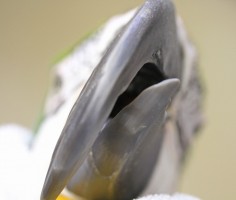
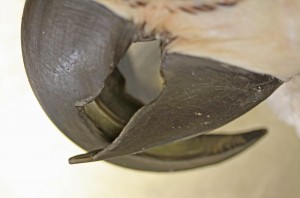
Scissor beak in a macaw, with upper beak deviated to the right of the bird, overlapping the mandible
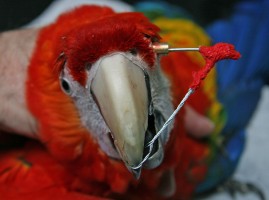
Young Scarlet Macaw, with orthodontic brace fitted to correct the deviation of the upper beak
ADULT FEMALE PROBLEMS
Hen parrots suffer from many egg-related conditions, which include no eggs or soft-shelled eggs. The former may simply be because the hen is immature, but both will result from poor diet and calcium deficiency problems. Egg-binding occurs when the hen has an egg in the lower oviduct and cloaca that she cannot deliver. This is another result of inadequate calcium – this mineral is needed not only to form the eggshell, but also for proper muscle contraction. Cold, damp conditions will affect proper delivery as well. Most cases will respond to warmth, fluids and calcium. Some birds will require gentle massage of the egg, with lubrication, to manoeuvre it down the oviduct, but such handling should be performed with care as the increased abdominal pressure can compromise the bird’s breathing. Extreme cases may need to have the egg collapsed by sucking out its contents with a needle; or else surgery may be necessary to remove the egg from the oviduct. In these circumstances it is important to ensure that no egg-shell fragments remain.
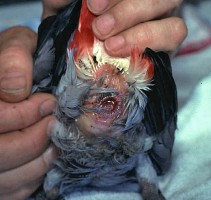
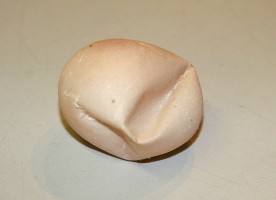
Left - African grey hen having difficulty passing an egg; Right - soft-shelled egg.
Some prolific egg-layers will prolapse their oviduct or cloacal lining, and this will require professional surgical repair and replacement. Many hens will suffer a partial paralysis of one or both legs after producing a large egg. This again may be linked to calcium deficiency, but also to bruising. It is usually temporary, and will respond to therapy with calcium and anti-inflammatory drugs plus soft support for the body.
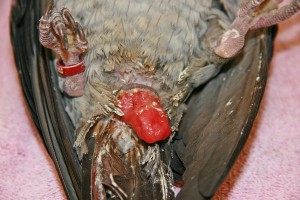
Prolapsed oviduct in a hen African grey parrot
Over-production of eggs is encountered in budgerigars, lovebirds, and especially cockatiels, which tend to be prolific breeders. This is controlled by reducing the photoperiod (daylight length) by closing curtains or covering the cage; by removing toys and mirrors that may stimulate breeding behaviour; and by not handling or stroking the bird excessively over its rump or under the wings, since this activity will stimulate breeding behaviour. Eggs that are laid should NOT be removed, since this will simply encourage the hen to lay more to replace them, and this will tire her out and deplete her calcium reserves. Three or four eggs should be left with her. Even a single hen may sit on this clutch and attempt to incubate them, but being infertile obviously nothing will happen. The hen eventually will realise that there is no activity inside the eggs, and will lose interest and come away from them. That is the time to remove them from her, but at least her system has had time to rest and recover from the process. Really severe and persistent cases may require hormone therapy or even surgical removal of the oviduct (salpingectomy) – the equivalent of a hysterectomy in a mammal.
Egg-peritonitis and retained dried inspissated eggs are extremely common in poultry, but will occur in parrots, notably cockatiels. Peritonitis follows leakage of egg material into the abdominal cavity, resulting in an inflammatory response, secondary infection, swelling and fluid accumulation. This may be fatal if not treated, and will require at least flushing and cleaning of the abdominal cavity, or even salpingectomy. Inspissated eggs are concentric layers of yolk material impacted on each other and drying out, forming a firm mass within the oviduct. This condition would also require surgical correction.
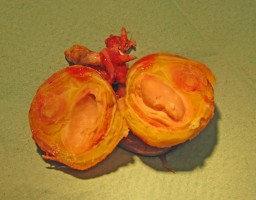
Inspissated egg cut in half - layers of yolk material built up like an onion inside the bird, and dried out
Tumours and cysts involving the ovary may be found in adult hens. These will manifest as irregular egg-laying, abdominal swelling, colour change of the cere in the budgerigar, or lameness resulting from the pressure of the enlarged tissue on the pelvic nerves.
ADULT MALE PROBLEMS
Masturbation is a frequent behavioural problem in pet parrots. These are usually single pet birds, strongly bonded to the owner, and stimulated by the owner’s incessant stroking of the rump and under the wings. Cockatoos, cockatiels and budgerigars are the prime culprits. Persistent masturbation will lead to cloacal soreness and even prolapse.
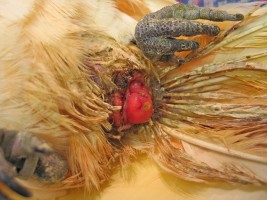
Prolapsed cloaca in a Moluccan cockatoo that persistently masturbated
Aggression is also linked with testosterone-production in adolescent or adult males. Natural territorial defence and displays will occur between rival breeding males in aviary collections, but such sexual aggression can become a problem when it occurs in the indoor pet bird. Very often it is the hand-reared parrot that has no fear of humans that can be the most troublesome, with cockatoos and some Amazons being the worst culprits. Management is by behavioural training techniques, or in some cases hormone therapy can be very effective.
Infertility can be a problem in birds intended for breeding. It may simply be the result of immaturity and inexperience, in which case the parrot will learn in time, and especially if he is placed with an older hen or is able to observe other birds. Poor diet will have an influence, so proper nutrition needs to be addressed, with possible supplements, especially those containing vitamin E. Physical problems may make the act of mating difficult. These would include leg or foot injuries, deformities, or arthritis; obesity; or cloacal papillomata. These are virus-induced warts, especially common in green-winged macaws, some Amazons, and hawk-headed parrots (Deroptyus accipitrinus). They will grow just inside, and protrude from, the cloaca (vent) of both sexes, and provide a physical barrier to successful mating.
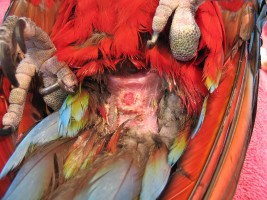
Cloacal papilloma in a Green-winged macaw
Cock birds will also get tumours of their testes, and again budgerigars are the most frequently affected species. As with the hens, the resultant organ swelling will press against the pelvic nerves, causing partial leg paralysis, loss of bodyweight, and usually a distended abdomen. Abnormal hormones produced by the tumour may produce a colour change from blue to brown in a budgie’s cere, or behavioural changes in all birds.
Alan K Jones updated Nov 2020
